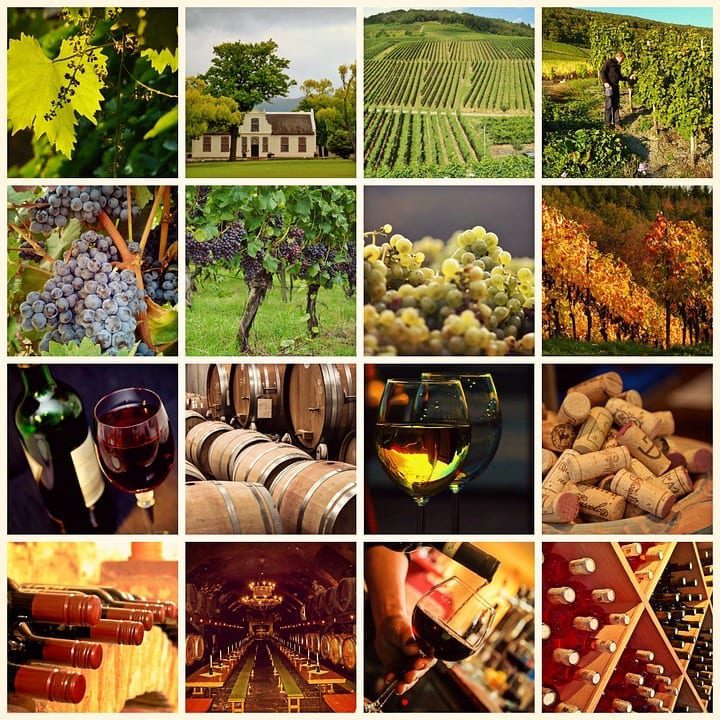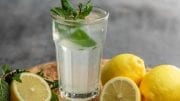Red wine is made from grapes that are red, blue or purple in color. But how does red wine become red, since white wine can also come from red grapes? The red color occurs when the light-colored juice remains in contact with red grape skins during the fermentation process. Grape skins also provide tannin, which is an important factor in the way a red wine tastes.
Red wines tend to be a bit more complex than white. They’re usually served at room temperature, which, according to some experts, is too warm. Chill red wine for 10 to 15 minutes (or until the bottle feels cool to the touch) for maximum enjoyment.
Popular red wine types include cabernet sauvignon, merlot, pinot noir, beaujolais, lambrusco, chianti, zinfandel, burgundy and bordeaux. Many of the world’s finest wines are a blend of varietals: almost all Bordeaux red wines contain Cabernet Sauvignon, Merlot and Cabernet Franc; almost all Champagnes contain Pinot Noir and Chardonnay. A wine which is a blend of Cabernet and Merlot, for example, is often more complex than a wine which is 100% Cabernet Sauvignon. Exploring varietal characteristics makes for a richer wine experience.
Cabernet Sauvignon
This is the grape responsible for the wines of Bordeaux’s Medoc region, arguably some of the finest reds in the world. It performs well practically the world over, as long as it’s not too cold, but in certain appellations in France, and more recently in California’s Napa Valley, it produces wines that astonish with their richness and complexity. One theory holds that blending Cabernet grapes with Merlot and Cabernet Franc or Petite Verdot adds character and complexity and offsets its great tannin (such is the case with wines of Bordeaux), while other winemakers (Californians, notably) prefer to let Cabernet tell its own story with no help. The classic Cabernet flavor is one of deep, dark fruits, primarily blackcurrant (cassis) and the best are medium- to full-bodied, intense and firm. Cabernets are almost always aged in oak for over a year, and should age several more years in the bottle. The great Cabernets of the Medoc region in France age for 15 years and more.
Cabernet/Merlot Blend
We are using the designation Cabernet/Merlot blend to indicate those wines which are often referred to as reserve bottlings, as special selections, as proprietary names (such as Opus or Insignia), or as ”Meritage” blends. Wineries the world over are following the Bordeaux-established style of blending Cabernet Sauvignon with Merlot (and sometimes a little Cabernet Franc, Malbec and Petit Verdot) to create a more complex wine. We have also included in this category wines from Oregon, Australia and California that are increasingly indicating on the front wine labels that the Cabernet-based wine is a blend. These Cabernet/Merlot blends are frequently the producer’s finest bottlings.
Chianti
Around the medieval cities of Florence and Sienna in Tuscany is the region of Chianti. It is broken up into seven subdivisions: the most famous region is called Chianti Classico, and close on its heels, Chianti Ruffina; then Chianti Montalbano, Chianti Colli Fiorentini, Chianti Colli Senesi, Chianti Colline Pisane, and Chianti Colli Arezzo. Only the first two are commonly seen on labels. The Medici Grand Duke Cosimo III first defined the region in 1716; in the second half of the 19th century, Baron Ricasoli fixed the recipe for modern Chianti, which is a blended wine as are most French Bordeaux. The dominant grape in Chianti is Sangiovese, but it may also contain Cabernet Sauvignon and other grapes. Once famous worldwide as a simple, quaffing wine bottled in a straw basket, the finest wines of the region have always been packaged in a Bordeaux-shaped bottle. The Chianti wines labeled ”Riserva” must be aged a minimum of three years and are often fine, age-worthy wines that rank among the best red wines of Italy. Chianti, of course, is a perfect red wine to accompany most Italian cuisine; the best often feature hints of floral complexity in the bouquet, firmly structured medium-bodied flavors and balancing acidity.
Merlot
Merlot wines have soared in popularity in the last decade, as they offer something for everyone: from light and simple wines to full-bodied and complex bottlings. Merlots are often less tannic and more lush than Cabernets, though still full-bodied, deep in color and fairly high in alcohol with flavors of cherry, plum and chocolate. Merlot is blended with Cabernet Sauvignon at almost all the great estates of France’s Bordeaux region and is the dominant grape of St. Emilion and Pomerol; for example Chateau Petrus is almost 100% Merlot. Other areas where Merlot has been successfully grown (and frequently blended into Cabernets to produce a more complex wine) include northern Italy, California, Washington and the Rogue Valley region of Oregon.
Pinot Noir
To grape growers and winemakers, Pinot Noir presents both the ultimate challenge and the ultimate reward. At their best, Pinot Noir grapes produce wines that are rich and complex, tasting of black cherries, red berries, earth and spice, with an aroma that’s been likened to everything from herbs and cola to bacon and roses. Pinots can be high alcohol, light in color and low in tannin, though oak aging can increase the tannin levels. One of the most exciting developments in the world of wine is the recent advances Oregon and California winemakers have made in producing first rate Pinot Noirs, respectable rivals to the legendary reds of French Burgundy. Most other Pinot Noirs produced around the world are pale imitations of Burgundy, usually lacking depth, elegance, richness and texture. You may wonder why anybody would bother with such a troublesome, fussy, hard-to-grow, enigmatic grape, but at their best there is no wine in the world that can offer more seductive, velvety, complex flavors than a fine Pinot Noir.
Red Bordeaux
Bordeaux is a region in France that produces some of the world’s finest and most famous red, white and dessert wines. The greatest red wines of Bordeaux come from the Medoc, Graves, Saint-Emilion and Pomerol; dry white wines mostly from Graves; and dessert wines from Sauternes, Barsac and Sainte-Croix-du- Mont. The red wines are almost always blends which include Cabernet Sauvignon, Merlot and Cabernet Franc, with sometimes small amounts of Malbec and Petit Verdot. The white and dessert wines consist of mostly Sauvignon Blanc and Semillon. Many of the world’s most spectacular and sought-after wines come from this region, including Chateaux Lafite-Rothschild, Mouton-Rothschild, Petrus, Cheval Blanc, Haut-Brion, Latour, d’Yquem, etc.
Red Burgundy
Burgundy red wines are produced in an area of France stretching from Dijon south to Beaujolais. The northern section of Burgundy is called the Cote d’Or (hills of gold) and generally, the farther north the vineyard, the richer flavored the wine. Here the Pinot Noir grape produces deliciously seductive wines combining grace and power with supple velvet textures and complex flavors. Many of the finest vineyards are located halfway up the hillsides, midway between overly fertile valley soils and the too steep and rocky upper slopes. These meager soils are seasoned with chalk and limestone and are not too rich–perfect conditions for vines to produce some of the greatest wines in the world.
The Cote d’Or is divided into a northern half called the Cote de Nuits and a southern half called the Cote de Beaune. The Cote de Nuits is red wine country, and makes the firmest red Burgundies. The Cote de Beaune is also white wine country, and its reds are typically more graceful and delicate than the wines from the Cote de Nuits. The vineyards are divided into four classes: vineyards that make only plain Bourgogne rouge; vineyards that make wine labeled by the name of the village (also known as commune); vineyards that are designated ”premier cru;” and the very greatest vineyards designated ”grand cru.” Fine values can often be found from lesser-known villages like Santenay, Auxey-Duresses, Savigny-les-Beaune, Meursault (usually thought of as a village for white Burgundy only), Morey-St.-Denis, and Fixin. The famous Hospices de Beaune name and wine label refers to a centuries-old hospital located in the town of Beaune, which is supported by the sale of Burgundy wines.
Syrah / Shiraz
Syrah is a rich, full-bodied, complex, spicy, long-lived wine that thrives in the Rhone region of France and produces such famous wines as Hermitage and Cote-Rotie. It is the most popular red wine of Australia (where it is called Shiraz and is often blended with Cabernet Sauvignon) and is becoming increasingly popular in California (where it is replacing another Rhone grape called Petite Sirah in America). Syrah can be successfully blended with many other wine grapes (often to give them more backbone and structure); it also can be made in a variety of styles ranging from soft and medium-bodied with some berry characteristics to deeply colored, powerful monsters tasting of roasted peppers, black cherry and smoke. Like California Zinfandels, American Syrahs can be full-bodied wines but often show more spice elements and less berry-like fruit than Zins.
Zinfandel
Zinfandel is a “new-world” grape varietal that been around for a long time. It is the one varietal that some say is indigenous to California. Since its mysterious origins of long ago, zinfandel has come a very long way. Once considered a lowly step-child to more noble grapes, California winemakers lately have been paying close attention to its potential and consumers have responded with a cult following.
After suffering an image problem in the 80’s when people associated it mostly with its “white” counterpart, zinfandel in its true form, earned mainstream recognition first with the 1990 vintage, which was emphasized a few years later with 1994’s stellar vintage. Cut to early fall 1998. By now many small, artisan wineries were making only zinfandel, and many medium to large producers had joined the club. Some were releasing 1997 zins and the positive predictions of the vintage were confirmed. 1997 had been quite warm, but zinfandel fruit loves this weather and it thrived in the heat. The wines are big, robust, and incredibly concentrated. At the annual ZAP showcase in the spring of 1999 – a virtual festival of all things zinfandel – the hype was on, and retailers were in full buying frenzy. Producers across the board were making some of their best wines ever. The amount of great wines was astonishing and this writer can say it was one of the most exciting tastings I’ve ever been to.





Be the first to comment on "Red Wine: Everything you need to know"